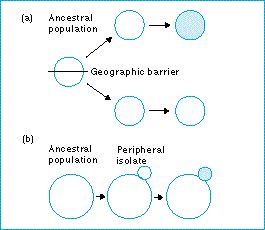Allopatric speciation

Allopatric speciation occurs when a new species evolves in geographic isolation from its ancestor. It can happen like this:
One species could split into two if a physical barrier, such as a new river, divided its geographic range. If the barrier is large enough, gene flow between them would cease and the two separate populations would evolve independently. Over time, different alleles would be fixed in them, either because of the hazards of mutation and drift, or because selection favored different characters in the two.
If the two populations are separated long enough for significant divergence to have taken place, then if the barrier is removed and the populations are reunited, they might remain distinct from each other. A prezygotic or postzygotic isolation mechanism would prevent them from inter breeding. There would now be two species where there was formerly one.
An animation illustrates the process of allopatric speciation.
Figure: two models of allopatric speciation. (a) The dumb-bell model in which the ancestral species is divided into two roughly equal halves, each of which forms a new species. (b) The peripheral isolate model, in which the new species forms from a population isolated at the edge of the ancestral species range.
| Next |



